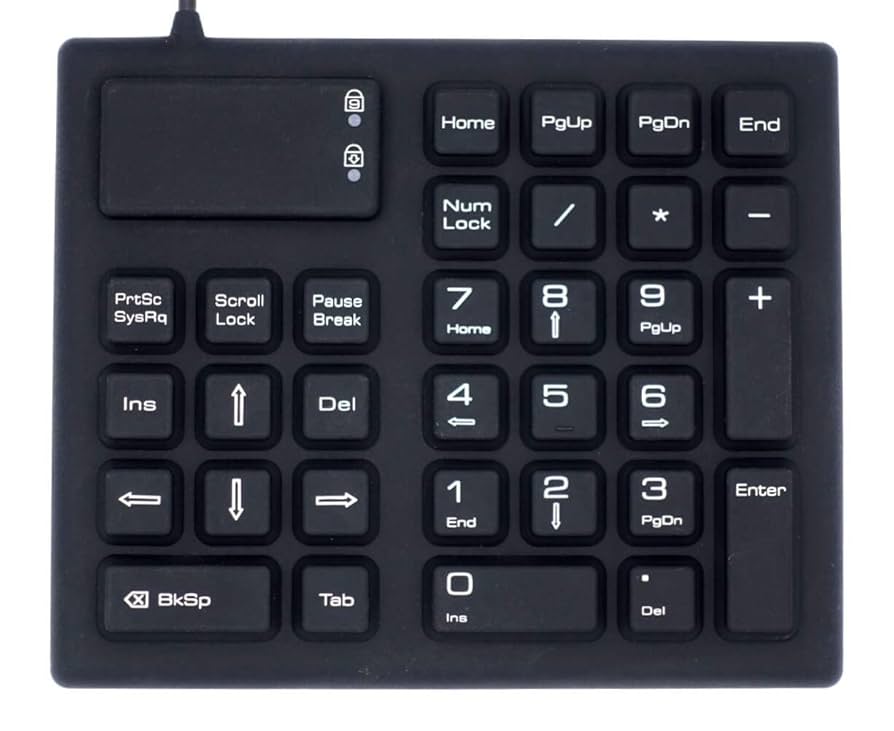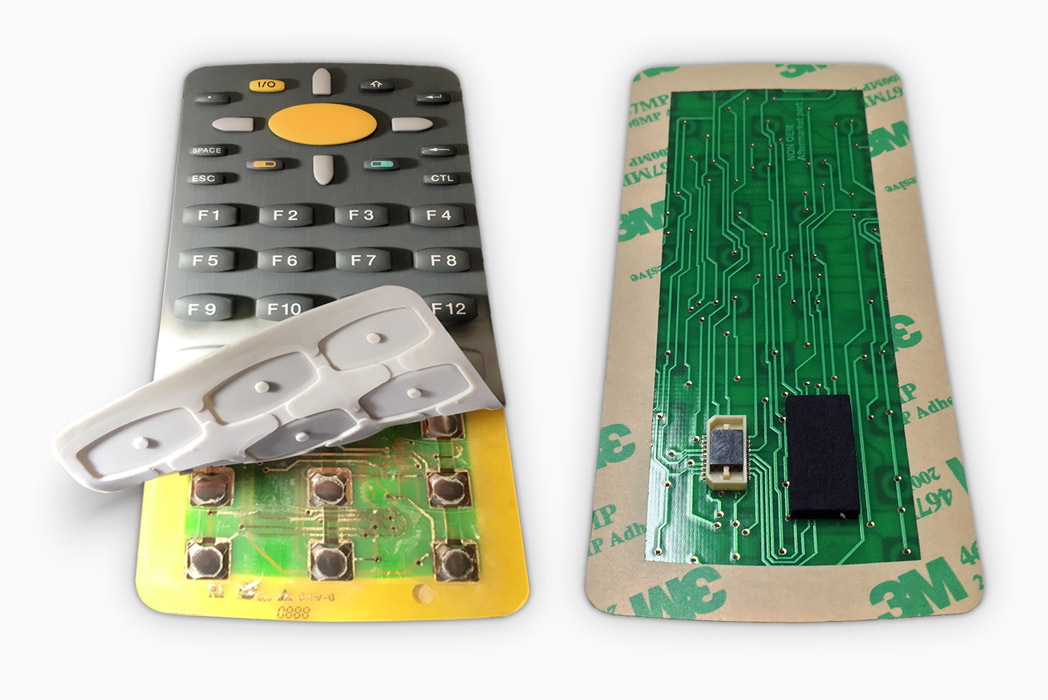The complete resource to designing long-lasting Rubber Keypads
A Comprehensive Overview to the Production and Handling of Rubber Keypads for Ideal Performance
The manufacturing and processing of rubber keypads play an essential role in their efficiency and use. Material choice, style precision, and sophisticated production techniques greatly affect their sturdiness and effectiveness. Recognizing these components is vital for producing high-quality items. As various innovations arise in this area, discovering their ramifications could reveal new criteria for performance and customer experience. What key aspects will form the future of rubber keypads?
Understanding Rubber Keypads: Products and Kinds
Rubber keypads are important parts in plenty of gadgets, using a balance of durability and responsive responses. These keypads are primarily made from silicone or artificial rubber, products selected for their versatility and durability. Silicone rubber, specifically, is preferred for its outstanding temperature resistance and longevity, making it perfect for various applications, from customer electronic devices to industrial machinery.
There are numerous sorts of rubber keypads, including dome button keypads, which utilize a dome-shaped mechanism that provides responsive feedback when pressed. Furthermore, there are likewise flat keypads, which include a smooth surface and are usually utilized in push-button controls and medical devices. The choice of product and type affects the keypad's performance, feel, and total individual experience. Recognizing these aspects is crucial for producers and designers intending to produce trusted and reliable interfaces in their items.
The Production Process: From Layout to Manufacturing
The production process of rubber keypads involves several vital phases, beginning with design and finishing with manufacturing. Developers produce detailed specifications and prototypes, assuring the keypad meets visual and functional needs. Computer-aided layout (CAD) software is frequently utilized to imagine the format and attributes before continuing.
When the style is finalized, product selection is vital, with options commonly including silicone or natural rubber. In the following phase, molds are created based on the authorized designs, which will form the keypads throughout manufacturing.
Complying with mold creation, the manufacturing phase starts, where rubber is blended with additives to enhance efficiency. The combination is then poured right into mold and mildews and subjected to warm and stress, allowing it to solidify and treat.
Lastly, the finished keypads go through top quality checks to verify they meet well established requirements, adhered to by packaging for distribution. This all-encompassing procedure guarantees peak performance in the end product.
Secret Strategies in Rubber Molding
In the domain name of rubber keypads, numerous molding strategies play a crucial role in establishing the high quality and functionality of the final product. One widespread approach is compression molding, where raw rubber is placed in a heated mold and pressure is used, permitting reliable mass manufacturing and uniformity. Another significant strategy is injection molding, which involves injecting heated rubber into a mold and mildew, using greater precision and facility shapes. Transfer molding, a hybrid of both techniques, is likewise made use of, particularly for complex designs, as it incorporates the benefits of both processes. Furthermore, liquid silicone rubber (LSR) molding is acquiring grip because of its flexibility and sturdiness, making it optimal for high-performance applications. Each method possesses unique features, influencing elements such as cycle time, product waste, and production expenses. Selecting the appropriate molding technique is crucial for achieving peak efficiency in rubber keypads.
Surface Finishing and Texturing Options
Surface area completing and texturing choices play a crucial duty in enhancing the responsive experience and aesthetic appeal of rubber keypads. Manufacturers utilize numerous strategies to produce unique surface area features that impact individual interaction and item design. Common completing approaches consist of matte, glossy, and satin surfaces, each providing various aesthetic effects and grasp degrees. Texturing alternatives, such as increased patterns, grooves, or stippling, additionally improve capability by enhancing grip and lowering slippage throughout use.
In addition, specific appearances can be customized to fulfill ergonomic requirements, supplying convenience during prolonged usage. The option of surface area finishes and appearances can be influenced by the desired application of the keypad, whether it be for consumer electronics, auto controls, or industrial devices. Eventually, cautious factor to consider of these options adds significantly to individual contentment and overall product performance, making them critical aspects in the layout and production process of rubber keypads.
Quality Assurance Actions in Rubber Keypad Manufacturing
Quality assurance measures in rubber keypad production are essential for making sure product integrity and performance. These steps incorporate material selection criteria, strenuous screening treatments, and stringent final assessment criteria. Together, they develop a thorough framework that aids producers copyright learn this here now top quality throughout the manufacturing process.

Material Choice Standards
Selecting the ideal products for rubber keypads is important, as it straight influences their customer, capability, and resilience experience. Key requirements for material choice consist of tensile strength, resilience, and ecological resistance. The option of rubber substance, such as silicone or thermoplastic elastomer (TPE), plays an important duty in attaining desired tactile feedback and longevity. Additionally, elements like chemical compatibility, temperature security, and UV resistance should be taken into consideration to assure maximum performance in various applications. Producers ought to also assess the convenience of handling and cost-effectiveness of materials, stabilizing quality with budget plan constraints. Eventually, the right product option not just enhances the keypad's performance however also adds to total item high quality and customer fulfillment.
Checking Treatments Executed
After identifying the suitable products for rubber keypads, extensive screening procedures are carried out to confirm that the last products satisfy sector requirements and consumer expectations. These procedures typically consist of mechanical screening, which reviews the toughness and elasticity of the rubber under various conditions. Furthermore, environmental testing evaluates the keypads' efficiency under temperature level fluctuations, humidity, and direct exposure to chemicals. Electric screening verifies the keypads operate correctly with electronic components, validating responsiveness and conductivity. Responsive comments is evaluated to assure customer contentment. These extensive screening measures are crucial in recognizing any kind of incongruities or defects before automation, eventually enhancing the reliability and performance of rubber keypads in their designated applications.

Final Assessment Specifications
Thorough final inspection requirements are crucial in rubber keypad manufacturing to guarantee that each device satisfies the specified criteria for functionality and appearance. This procedure typically involves visual assessments to recognize any type his response of surface problems, such as discoloration or blemishes. Additionally, responsive assessments establish that the keypads respond precisely to touch, preserving the called for degree of sensitivity. Longevity examinations might likewise be carried out, simulating extended usage to confirm the durability of the keypad under numerous problems. In addition, adherence to sector guidelines and customer specs is verified to keep top quality assurance. By applying these extensive inspection measures, suppliers can greatly minimize the danger of problems, ensuring that the last product is trusted and fulfills consumer assumptions, ultimately improving client contentment.
Advancements in Rubber Keypad Modern Technology
As innovation remains to advance, technologies in rubber keypad modern technology are improving user interfaces throughout various industries. One considerable development is the integration of capacitive touch sensing units within rubber keypads, permitting a more responsive and view publisher site functional user experience. This technology enables individuals to engage with devices through touch, enhancing capability without giving up the tactile feedback that rubber keypads are known for.
In addition, improvements in product formulas have resulted in the growth of more resilient, weather-resistant rubber, making keypads suitable for industrial and outside usage. Enhanced printing techniques additionally enable high-resolution graphics and backlighting alternatives, increasing exposure and visual allure.

Furthermore, developments in manufacturing procedures, such as 3D printing, are enabling custom-made layouts and rapid prototyping, simplifying manufacturing timelines. These advancements collectively add to much more reliable and straightforward rubber keypads, ensuring they satisfy the demands of modern applications while preserving their core benefits.
Finest Practices for Style and Capability
Creating effective rubber keypads calls for careful analysis of both visual appeals and performance. Rubber Keypads. A well-designed keypad ought to balance ergonomic principles with aesthetic interest enhance user experience. Secret aspects include dimension, form, and spacing of buttons, ensuring they are very easy to press while stopping unexpected activation. Making use of contrasting shades and textures can improve visibility and responsive responses, assisting users in comparing tricks
Additionally, the selection of materials plays a necessary function; high-grade rubber substances can boost toughness and resistance to wear. It is also vital to consider the integration of functions such as backlighting and personalized graphics, which can boost functionality in different settings.
Finally, prototyping and customer screening are vital in the layout process, enabling for changes based upon real-world feedback. By adhering to these ideal practices, producers can develop rubber keypads that not just look attractive but likewise fulfill the useful requirements of users efficiently.
Frequently Asked Questions
Just how Do I Choose the Right Rubber Product for My Keypad?
To pick the right rubber material for a keypad, one should think about elements such as toughness, environmental resistance, tactile responses, and compatibility with the desired application, guaranteeing optimal performance and user satisfaction in different conditions.
What Are the Ecological Influences of Rubber Keypad Production?
Rubber keypad manufacturing can result in ecological influences such as deforestation for natural rubber resources, air pollution from chemical processes, and waste generation. Sustainable techniques and products can alleviate several of these unfavorable effects on ecological communities.
Can Rubber Keypads Be Recycled or Reused?
Rubber keypads can be recycled, yet the process depends upon the certain products made use of in their manufacturing. Recycling them in different applications is additionally feasible, adding to lose reduction and promoting sustainability in making practices.
What Is the Average Life-span of a Rubber Keypad?
The ordinary life expectancy of a rubber keypad generally varies from 5 to one decade, depending on use, environmental factors, and maintenance. Normal treatment can prolong its capability, while extreme wear might shorten its sturdiness.
Exist Any Type Of Health And Wellness Worries Associated to Rubber Keypad Products?
There are prospective health problems associated with rubber keypad materials, consisting of allergies to specific chemicals and irritants made use of in production. Correct handling and understanding of product composition can alleviate these risks for customers.
There are a number of kinds of rubber keypads, including dome button keypads, which make use of a dome-shaped device that supplies tactile comments when pushed. Selecting the suitable products for rubber keypads is important, as it directly impacts their toughness, capability, and user experience - Rubber Keypads. After identifying the ideal products for rubber keypads, extensive screening procedures are executed to validate that the last items satisfy sector requirements and customer expectations. Rubber keypad manufacturing can lead to environmental impacts such as deforestation for natural rubber resources, air pollution from chemical procedures, and waste generation. Rubber keypads can be recycled, but the process depends on the specific products utilized in their production